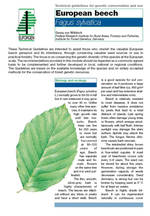Fagus sylvatica - Technical guidelines for genetic conservation and use for European beech
This publication has been translated into the following languages:
French Slovenian Polish
Genetic diversity of beech should be conserved using a mix of in situ and ex situ approaches. For reforestation, the minimum requirement should be that the origin of the reproductive material is known and its adaptive characters should be appropriate for the ecological conditions at the new site. This is especially important in places where beech is to be re-introduced but little knowledge on site-adapted populations exists, e.g. where beech is used to replace maladapted conifer stands that have been planted on former beech sites.
Besides the present regulations for documenting forest reproductive material in trade, a monitoring system for the use of reproductive materials should be applied. Recommendations should be developed on proper use of different materials in the face of climate change, together with transfer guidelines. The EU directive and OECD scheme provide basic regulations on the transfer of reproductive materials. In years with abundant seed production, beech seed should be harvested and stored in sufficient amounts to capture the widest range of genetic diversity.
Beech can usually be conserved in situ in normal stands. In many parts of Europe seed stands alone may not be enough for the conservation of genetic resources of beech. Therefore, there is a need for gene reserve forests. These are natural stands managed to ensure successful natural regeneration, e.g. through thinning and harvesting older trees. The objective is to maintain continuous evolution of a tree population. Such gene reserve forests should cover at least 100 ha in order to contain sufficient genetic variability. For small, locally adapted populations, however, it may be better to establish a large number of smaller reserves.
The establishment of ex situ conservation plantations of beech may be necessary in order to conserve the genetic variation of threatened populations that cannot be maintained at the original site. The objective is to maintain as much as possible of the original genetic variability and to allow continuing adaptation to local conditions. Ex situ conservation stands should cover 2–5 ha, and can be established by planting seedlings or by direct sowing.
Authors: Georg von Wühlisch
Corporate Author: Bioversity International, Rome (Italy)
Journal/Series:
EUFORGEN Technical Guidelines for Genetic Conservation and Use
Publication Year: 2008
Publication Format: 17x24 Softcover
ISBN 13: 978-92-9043-787-1
Language: EN
Pages: 6 p.
Technical guidelines Fagus sylvatica

